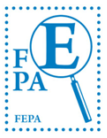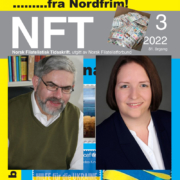An interview with the Makers of MICHEL in NFT
We received the following press release by MICHEL on 24th May.
The Norwegian collectors’ magazine Norsk Filatelistisk Tidsskrift (No. 3/2022) published an interview with the MICHEL editors-in-chief. Journalist Øyvind Refsnes asked the longtime editor-in-chief Oskar Klan and his successor Marion Flieger a few questions that will certainly also be of great interest to collectors elsewhere.
You can read the MICHEL press release in pdf format here or in free text form right below.
Photo collage: NFT cover, Oskar Klan, Editor in Chief, and Marion Flieger, Executive Editor
[photos credit: NFT cover: Norsk Filatelistforbund; Michel Editors: Michel]
The collector’s areas of interest surprise us again and again!
ØR: First, congratulations from Norway to the leading catalogue-publisher in the world. How is it possible to publish so many catalogues in a year – how many people are working on it on a day-to day basis, and how many ”freelancers” around the world do you have to do this tremendous work?
MICHEL: Thank you, the whole team of 12 full-time and 3 part-time editors is always doing its best to: publish the ambitious program with the treasured and helpful insights of many hundreds
„freelancers“. A good part of those are specialized in German stamps, another part in the rest of the world. But there are also a lot of people who are helping with new issue information and with special topics.
ØR: When was the first Michel-catalogue published? Can you give us a short history of the firm from the start up to today?
MICHEL: The first MICHEL-Europa (with Germany) was published in 1910 by Hugo Michel, a stampdealer in Apolda, Thuringia. In 1920 he sold his interests to “Verlag des Schwaneberger Albums Eugen Berlin GmbH” of Leipzig, Saxony. Eugen Berlin extended the range first to Overseas countries and published the first MICHEL-Germany Specialized in 1934/5. In 1943 the premises of the company were destroyed in an air raid, but a last catalogue called “Großdeutschland” was published in 1944. Somehow Eugen Berlin managed to remove the printing implements from Leipzig to his house near Coburg, Bavaria, where he planned to live in his retirement. So these important tools happened to be in the American Zone of Occupation and not in the Soviet Zone when the iron curtain fell. After the currency reform of 1948 Eugen Berlin started to work on a new edition, as a start only for German stamps. Printing was done by Carl Gerber of Munich, which later bought the catalogue when Eugen Berlin sold it due to bad health. He died in 1951. The range of volumes was again implemented, Germany, Europe and Overseas, in 1964 the first postwar edition of Germany Specialized was published. The editorial work was done in Munich by an expanding team of editors.
In 1970 Hans Hohenester the elder became head of the company. He started to increase the number of titles by a range of new ones. Among others these were Postal Stationary of Germany, a simplified volume on Germany called „MICHEL Junior“ or the Volume on the stamps for the European Postal Community CEPT. Books on specific subjects were added like Zeppelin Post or German Field Post from WW2. In 1981 his son Hans Hohenester the younger joined the company, of which since 2001 he is the CEO. He introduced the digital age to MICHEL, first with the program MICHELsoft to manage a collection, then with electronic databases for the catalogue production and especially with MICHEL Online, the digital worldwide stamp catalogue for collectors. Work on our products never ends, they are continuously updated and upgraded by our editorial staff with the help of the 4 people in the IT-department. Regularly new products are introduced such as the customized catalogues of MeinMICHEL or our new range of translations to English.
ØR: How many titles are you publishing in a normal year now? Which one are the bestselling catalogues, and which ones do you publish with really few copies sold?
MICHEL: In 2022 we plan to publish 39 titles. Bestsellers are of course the books on German stamps, and some very specialized titles have the lowest numbers printed.
ØR: Is there really a market for catalogues for the whole world? Take some parts of Africa as an example, where there are issued hundreds and hundreds of stamps and blocks every year. Is there really so many collectors also for countries like these to make it worthwhile to publish new editions?
MICHEL: Yes, there is. Of course, certain countries are more collected than others, but you will find a collector for every country under the sun and for every theme you can imagine. This we learned over time, and the interests of our customers sometimes surprise us. But you can see that some catalogues have more editions than others, so for some countries you have a greater
time span between editions.
ØR: Are there parts of the world now which is more popular as collecting-fields than before? Are there international trends among collectors, and especially among all the new collectors
that have found there boy/girl-collections again because of the pandemic?
MICHEL: Altogether you can notice the trend to topical collecting, while there are less collectors of countries than before. There still is the well-known trend to start with collecting the stamps of one’s own country. Asian countries are still growing in importance, which is not surprising. About half of mankind lives there, and many of them have money to spend on their hobbies. The pandemic had a rather huge side effect on leisure activities. The interest in philately grew stronger while outdoor and social activities decreased. Sure enough, we counted a lot of new customers
in our online shop.
ØR: Together with the country-catalogues you are publishing lots of other catalogues. Everything from chess to zeppelins and Ganzsachen. How many catalogues like these are there a market for? And which one of them are the most popular if you look at the sold copies?
MICHEL: Zeppelin and Postal Stationary are really in demand and among our best-selling titles. Our book about the German Army Postal Service in WW2 is also very popular. The demand of topical catalogues depends a lot on the topic of the particular titles and is therefore variable.
ØR: Are there collecting-fields in our hobby where you still have not published a catalogue, or are you covering every possible part of our hobby now?
MICHEL: There are more possible stamp collections than there are people on earth. There truly is a collector for everything you might imagine. And because of the limits of our imagination at
MICHEL, we developed the customizable MeinMICHEL. This product is Printed On Demand and contains only the very stamps that are desired by an individual collector. You can pick stamps from all over the world for this custom-fit catalogue. This way you can assemble your own MICHEL for your own individual collecting needs.
ØR: Splitting up Europe in 16 catalogues must have been a major step for Michel? What was the most important reasons for that, and how has the market reacted?
MICHEL: The most important reasons were the growing thickness of the seven volumes and therefore the diminishing convenience in handling them. Over the years the volumes became very unequal in the number of pages, too. With the split-up we followed the wish of our customers for more manageable and fitting volumes that are even lower priced than before.
ØR: If you look into the future, do you see that some Michel-catalogues only will be published on the net, not as printed catalogues?
MICHEL: The online trend has surely reached the philately. There are more online marketplaces for stamps than ever. Whereas MICHEL has reached major expertise, we are always developing
our online catalogue to satisfy even more of our customer’s needs. Ten years ago people predicted the death of all printed books for this time. Now we know that the new publishing forms are no longer replacing the old ones but extending them. Therefore printed books are unlikely going to disappear completely. And for that reason we are willing to publish today and in future every way that our customers want – print and online.
Please note: Released from MICHEL (Schwaneberger Verlag GmbH) for reprint with indication of the original place of publication: Øyvind Refsnes, Norsk Filatelistisk Tidsskrift, No. 3/2022.



